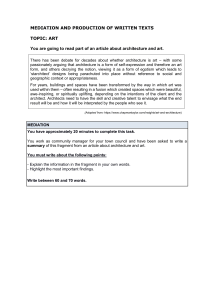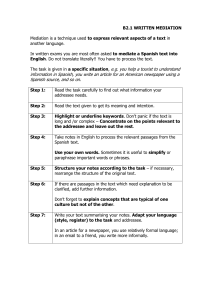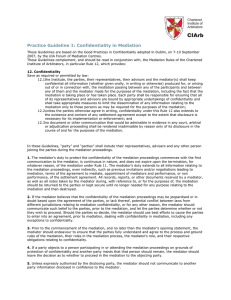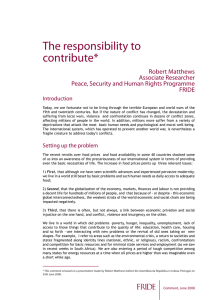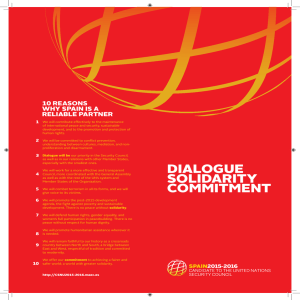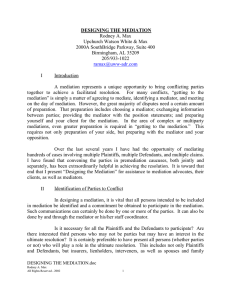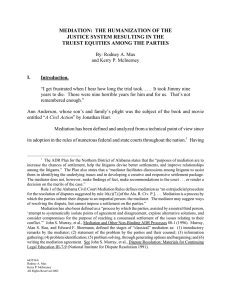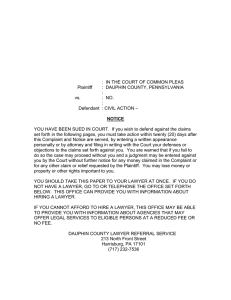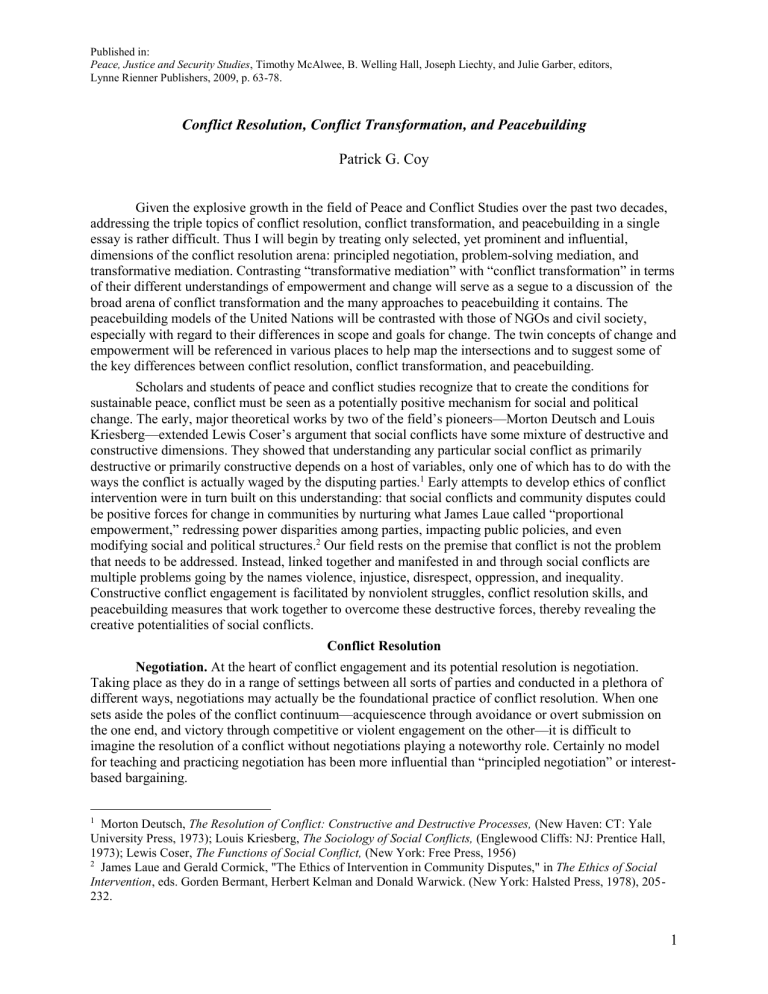
Published in: Peace, Justice and Security Studies, Timothy McAlwee, B. Welling Hall, Joseph Liechty, and Julie Garber, editors, Lynne Rienner Publishers, 2009, p. 63-78. Conflict Resolution, Conflict Transformation, and Peacebuilding Patrick G. Coy Given the explosive growth in the field of Peace and Conflict Studies over the past two decades, addressing the triple topics of conflict resolution, conflict transformation, and peacebuilding in a single essay is rather difficult. Thus I will begin by treating only selected, yet prominent and influential, dimensions of the conflict resolution arena: principled negotiation, problem-solving mediation, and transformative mediation. Contrasting “transformative mediation” with “conflict transformation” in terms of their different understandings of empowerment and change will serve as a segue to a discussion of the broad arena of conflict transformation and the many approaches to peacebuilding it contains. The peacebuilding models of the United Nations will be contrasted with those of NGOs and civil society, especially with regard to their differences in scope and goals for change. The twin concepts of change and empowerment will be referenced in various places to help map the intersections and to suggest some of the key differences between conflict resolution, conflict transformation, and peacebuilding. Scholars and students of peace and conflict studies recognize that to create the conditions for sustainable peace, conflict must be seen as a potentially positive mechanism for social and political change. The early, major theoretical works by two of the field’s pioneers—Morton Deutsch and Louis Kriesberg—extended Lewis Coser’s argument that social conflicts have some mixture of destructive and constructive dimensions. They showed that understanding any particular social conflict as primarily destructive or primarily constructive depends on a host of variables, only one of which has to do with the ways the conflict is actually waged by the disputing parties.1 Early attempts to develop ethics of conflict intervention were in turn built on this understanding: that social conflicts and community disputes could be positive forces for change in communities by nurturing what James Laue called “proportional empowerment,” redressing power disparities among parties, impacting public policies, and even modifying social and political structures.2 Our field rests on the premise that conflict is not the problem that needs to be addressed. Instead, linked together and manifested in and through social conflicts are multiple problems going by the names violence, injustice, disrespect, oppression, and inequality. Constructive conflict engagement is facilitated by nonviolent struggles, conflict resolution skills, and peacebuilding measures that work together to overcome these destructive forces, thereby revealing the creative potentialities of social conflicts. Conflict Resolution Negotiation. At the heart of conflict engagement and its potential resolution is negotiation. Taking place as they do in a range of settings between all sorts of parties and conducted in a plethora of different ways, negotiations may actually be the foundational practice of conflict resolution. When one sets aside the poles of the conflict continuum—acquiescence through avoidance or overt submission on the one end, and victory through competitive or violent engagement on the other—it is difficult to imagine the resolution of a conflict without negotiations playing a noteworthy role. Certainly no model for teaching and practicing negotiation has been more influential than “principled negotiation” or interestbased bargaining. 1 Morton Deutsch, The Resolution of Conflict: Constructive and Destructive Processes, (New Haven: CT: Yale University Press, 1973); Louis Kriesberg, The Sociology of Social Conflicts, (Englewood Cliffs: NJ: Prentice Hall, 1973); Lewis Coser, The Functions of Social Conflict, (New York: Free Press, 1956) 2 James Laue and Gerald Cormick, "The Ethics of Intervention in Community Disputes," in The Ethics of Social Intervention, eds. Gorden Bermant, Herbert Kelman and Donald Warwick. (New York: Halsted Press, 1978), 205232. 1 This problem-solving approach—predicated upon win-win philosophies—is closely associated with the Program on Negotiation at Harvard University. Roger Fisher and William Ury first published this approach in a slim volume entitled “Getting to Yes” in 1981. Packaged and written in an accessible manner, this practical primer has become the field’s first and, to date, only national bestseller; it has been translated into 31 languages, selling upwards of 5 million copies worldwide. Nearly 30 years later, this approach continues to be widely taught (albeit in modified forms, thanks in part to critiques from various quarters) in undergraduate and even graduate peace studies and conflict resolution programs as well as in alternative dispute resolution programs in law schools. Variants of an interest-based approach to negotiations are common in collective bargaining in the public sector.3 They are also widely practiced in diplomatic circles and form the foundational skill set upon which many facilitators and mediators rely and build upon. Interest-based bargaining has made a significant impact in the broad arena of public policy disputes generally and also in its intersections with environmental conflicts.4 This area of practice and its numerous subfields go by many different names, including environmental conflict resolution, public sector dispute resolution, consensus building, collaborative conservation, deliberative democracy, collaborative policymaking, and still others. Consequently, training in public sector dispute resolution tactics is increasingly present in both undergraduate and graduate curricula in peace and conflict studies. Mediation. Insofar as mediation often provides the medium in which negotiations occur, perhaps the shortest and sweetest definition of mediation is simply “facilitated negotiation.” And if negotiation is the foundational practice of conflict resolution, then mediation is its chief assistant. Mediation is increasingly used in interpersonal quarrels between neighbors when they find their way to a community mediation center or when the courts refer them there. It is also often the tactic of choice in environmental policy disputes that have multiple stakeholders, including government agencies that understand that if stakeholders are given a say in policies that impact them, they are more likely to adhere to those policies willingly and to watchdog their implementation.5 Of course, mediation also has a long and storied history in ethnic conflicts on the national level, as it does in international conflicts involving states and nations.6 There are as many ways to practice mediation as there are contexts within which it has been applied. 3 Renaud Paquet, Isabelle Gaétan, and Jean-Guy Bergeron. "Does Interest-Based Bargaining (IBB) Really Make a Difference in Collective Bargaining Outcomes?" Negotiation Journal 16, no. 3 (2000): 281-296. 4 Kirk Emerson et al., "The Challenges of Environmental Conflict Resolution," in The Promise and Performance of Environmental Conflict Resolution, eds. Rosemary O'Leary and Lisa B. Bingham. (Washington, DC: Resources for the Future, 2003), 3-26. 5 For a profile of community mediation in the U.S., see the many useful articles in the special issue of Mediation Quarterly devoted to evaluating community mediation’s progress after 25 years: Mediation Quarterly, Volume 17, Issue 4, 2000. Also see the website for the National Association for Community Mediation at http://www.nafcm.org/. On the practice of mediation in environmental conflict resolution, see Rosemary O'Leary and Lisa Bingham, The Promise and Performance of Environmental Conflict Resolution, (Washington, DC: Resources for the Future, 2003), and Lawrence Susskind, Sarah McKearnan, and Jennifer Thomas-Larmer, The Consensus Building Handbook: A Comprehensive Guide to Reaching Agreement, (Thousand Oaks, Calif.: Sage Publications, 1999). 6 Multiple case examples of mediation in ethnic conflicts can be found in the following three collections: John Paul Lederach and Janice Moomaw Jenner eds., A Handbook of International Peacebuilding: Into the Eye of the Storm, 1st ed. (San Francisco: Jossey-Bass, 2002); Luc Reychler and Thania Paffenholz eds., Peace-building: A Guide (Boulder: Lynne Rienner, 2001); Chester A. Crocker, Fen Osler Hampson, and Pamela R. Aall, Herding Cats: Multiparty Mediation in a Complex World, (Washington, D.C.: United States Institute of Peace Press, 1999). Many ethnic conflicts become internationalized. An analysis of mediation in 869 of these instances found that a directive style of mediation increased the probability of successful conflict management than did less directive approaches. See Jacob Bercovitch and Karl Derouen Jr., "Mediation in Internationalized Ethnic Conflicts: Assessing the Determinants of a Successful Process," Armed Forces & Society (Transaction Publishers) 30, no. 2 (2004): 147170. And for an overview of the practices of mediation in international conflicts more generally, see Saadia Touval and I. William Zartman, "International Mediation in the Post-Cold War Era," in Turbulent Peace: The Challenges of Managing International Conflict, eds. Chester Crocker, Fen Osler Hampson and Pamela Aall. (Washington, DC: United States Institute of Peace, 2001), 427-444. 2 Mediation can also be categorized in multiple ways, including by the social position of the mediator vis-à-vis the disputing parties, by the stage of the conflict at which mediation occurs, by the activities of the mediator, and by the mediation model used. Distinctions along these dimensions have led to a number of mediation typologies or categorization schemas, some more useful than others in teaching and training.7 To provide but one example, the “contingency model” of third party intervention ties analysis of the particular stage that a conflict is in with what is thought to be the corresponding, appropriate type of mediation attempted.8 We can also think of mediation as an important arena in which conflict resolution and conflict transformation intersect and bleed into each other, thanks in part to the various models of mediation. At one end of the mediation spectrum is the facilitative or problem-solving approach to conflict intervention. At the opposite end is transformative mediation. I will treat them in that order. Problem-solving approaches. Marked by the use of interest-based negotiations, what is known as problem-solving or facilitative mediation is often driven by the goal of achieving a settlement to the conflict. The dominant approach in the reformist stream of “alternative dispute resolution” (ADR) in the United States, problem-solving mediation is part of efforts to modify the court system so that it might offer a broader spectrum of services. These reformers speak figuratively of creating “multi-door courthouses.” Instead of funneling all disputes through one door leading only to court rooms with a judge or jury waiting to issue a pronouncement, they envision a legal system in which some disputants might still be assigned to the judge or the jury, while others are sent to a hearing room, or to mediation, arbitration, or some hybrid approach. Many lawyers, paralegals, and former judges who mediate within the ADR movement practice and promote the facilitative or problem-solving approach to mediation.9 These mediators rely heavily upon caucuses and shuttle diplomacy, work under time constraints imposed by the courts, and are not always shy about pressuring parties to settle. Mediators operating on the far edge of the problem-solving mediation model will also offer evaluative comments and opinions with regard to disputant positions and even interests. Transformative Mediation. At the other end of the continuum is transformative mediation. According to its main proponents, this approach is strongly values-based, concerned as it is with the “growth” and even the “moral” development of the disputants. Transformative mediators are only secondarily interested in attaining formal resolution to the conflict. Here the third party is primarily concerned with disputants experiencing recognition and achieving empowerment. Recognition refers to “the evocation in individuals of acknowledgement and empathy for the situation and problems of others.” Empowerment means “the restoration to individuals of a sense of their own value and strength and their own capacity to handle life’s problems.”10 Like the peacebuilding aspects of conflict transformation that 7 Useful categorization schemas covering the horizon of mediation-related third party roles include these three: Louis Kriesberg, "Varieties of Mediating Activities and Mediators in International Relations," in Resolving International Conflicts: The Theory and Practice of Mediation, ed. Jacob Bercovitch (Boulder: Lynne Rienner, 1996), 219-233; Christopher Mitchell, "The Process and Stages of Mediation: The Sudanese Cases," in Making War and Waging Peace, ed. David R. Smock, (Washington, DC: United States Institute of Peace Press, 1993), 139-159; and William Ury, The Third Side: Why We Fight and How We Can Stop, Updated and expanded, Rev.ed. (New York: Penguin Books, 2000), 251. 8 For the original articulation of the contingency approach, see Ronald Fisher and L. Keashly, "The Potential Complementarity of Mediation and Consultation Within a Contingency of Third Party Consultation," Journal of Peace Research 28, no. 1 (1991): 29-42. A recent assessment of its utility as applied in the field is included here, Ronald J. Fisher, "Assessing the Contingency Model of Third-Party Intervention in Successful Cases of Prenegotiation," Journal of Peace Research 44, no. 3 (2007): 3119 For an example of a popular training manual that is based on the problem-solving model of mediation, see Mark D. Bennett and Scott H. Hughes, The Art of Mediation, 2nd ed. (Notre Dame, IN: National Institute for Trial Advocacy, 2005). 10 Certainly the single most influential publication on transformative mediation is Robert A. Baruch Bush and Joseph P. Folger, The Promise of Mediation: Responding to Conflict Through Empowerment and Recognition, (San Francisco: Jossey-Bass, 1994). The quotations on recognition and empowerment are from p. 2. 3 we will examine later, transformative mediation also embraces change as a key goal. But here the change is focused on internal changes in the disputants and on transformations in their relationships. The most widespread application and institutionalization of the transformative approach to mediation has occurred within the United States Postal Service’s REDRESS program over the past 14 years. That experiment is old enough now to have produced empirical data about the effects of transformative mediation on a varied workplace with diverse employee and supervisor pools. To cite but one example, the research by Lisa Bingham and her colleagues is based on over 180,000 exit surveys collected over the first ten years of the program, 1994-2004. They found support for the notion that the systematic application of the transformative mediation model to a wide variety of workplace conflicts in the Postal Service’s REDRESS program has resulted in important shifts in the organizational culture of the Postal Service.11 While most agencies and their mediators privilege to varying degrees one or another model in practice, many hybrid approaches exist that combine transformative principles with problemsolving tactics. In fact, hybrid models are probably dominant at this point in the field. For example, even though community, neighborhood, and individual empowerment approaches have long been integral to community mediation centers in the United States, many centers nonetheless teach and practice a hybrid model of mediation that incorporates aspects of the problem-solving approach with transformative principles.12 This more community-based stream of the ADR movement is motivated by a desire to help individual citizens take back control of their conflicts from an inequitable court system. The approximately 500 community mediation centers in the United States are driven by the notion that most citizens can usually fashion constructive solutions to their own disputes, independent of the legal system, if they are provided supportive conflict resources. This less reformist and more grassroots wing of the ADR movement grew out of the many social movements of the 1960s-70s. It administers mediation and other conflict resolution services through neighborhood and community-based institutions that, while parallel to the courts and taking referral cases from the courts, strive nonetheless for independence from the legal system.13 Ongoing training of volunteer community mediators who reflect the diversity of the communities served, modeling constructive conflict behaviors, and neighborhood organizing work are all understood to have additive, “trickle-out” empowerment effects in communities, neighborhoods, workplaces, and families, as indigenous community leadership is empowered and conflict patterns are changed over time. Equally important, these community-based agencies aim to be exercises in citizen participation and democratic governance. This approach to mediation is apparently succeeding in building community capacities in some areas and doing less well in others. For example, a recent qualitative and quantitative study of 174 community mediation centers affiliated with the National Association for Community Mediation found that they have created moderate to strong linkages across organizations, established diverse funding sources and referral streams, and created boards of directors that are broadly representative of their respective communities. Community-based mediation agencies have, however, been somewhat less successful with participatory decision making and other means of citizen involvement.14 In addition, they face strong pressures of co-optation, the mixed “blessing” of many social movements that experience 11 For a helpful review of the outcomes of transformative mediation in the USPS, see Lisa B. Bingham, "Employment Dispute Resolution: The Case for Mediation," Conflict Resolution Quarterly 22, no. 1-2 (2004): 145174. 12 An excellent mediation training manual that falls between the two poles of the continuum (but still more closely to the problem-solving end), is Jennifer E. Beer and Eileen Stief, The Mediator's Handbook, Rev. & Expand 3rd ed. (Gabriola Island, BC: New Society Publishers, 1997). 13 For a critical analysis of how the complicated relationship between the court system and community mediation in the United States has evolved, see Timothy Hedeen and Patrick G. Coy, "Community Mediation and the Court System: The Ties that Bind," Mediation Quarterly 17, no. 4 (2000): 351-367. 14 Beth Gazley, Won Kyung Chang, and Lisa Blomgren Bingham, "Collaboration and Citizen Participation in Community Mediation Centers," Review of Policy Research 23, no. 4 (2006): 843-863. For two other useful evaluations of the community mediation approach, see Timothy Hedeen, "The Evolution and Evaluation of Community Mediation: Limited Research Suggests Unlimited Progress," Conflict Resolution Quarterly 22, no. 1 (2004): 101-133; and Daniel McGillis, Community Mediation Programs: Developments and Challenges, (Washington, DC: National Institute of Justice, 1997). 4 success in achieving some of their goals.15 Clearly, the change goals for conflicts in this approach are wider and go beyond relationship changes and internal changes in the disputants. With regard to the intersection of mediation skills-training and curriculum concerns in peace and conflict studies programs, it seems best that we introduce students to the particular philosophies that undergird the various mediation models as well as to the specific tactics and unique techniques used in the respective approaches. Indeed, after teaching and training on the various mediation approaches in our university course and also in community seminars, I frequently use an exercise in which all students/trainees situate themselves and the model of mediation they aspire to practice on a continuum with problem-solving mediation on one end and transformative mediation on the other. When this is complemented by small-group discussions based on questions designed to elicit each student’s reasons, hopes, and fears about where they placed themselves on the mediation continuum, the more likely outcome is critically, self-reflective practitioners. And critically self-reflective practitioners—who are also skilled in the full range of conflict resolution tools— are much more likely to select the tool or approach that is most appropriate to a particular conflict and that best resonates with the needs of individual disputants. Conflict Transformation While empowerment and recognition are at the heart of transformative mediation within conflict resolution, the focus there remains primarily short-term and is directed at the individual disputants. When we move out of the realm of conflict resolution and transformative mediation into the broader arena of conflict transformation, we focus less on mediation and more on a much wider set of skills and tactics associated with peacebuilding. Here mediation is only one in a host of skills and tactics.16 In the peacebuilding that is so closely associated with conflict transformation, empowerment and change are equally prized as conflict outcomes, but the field of view is much wider, theoretically encompassing structural changes beyond the individual disputants. Like the feminist worldview that has influenced it, conflict transformation’s field of view is also intended to be far deeper, addressing the root causes of social conflicts as much as possible, while recognizing that some conflicts are not resolvable until and unless fundamental arrangements are changed. Over time, the goal is to assist countries, societies, and groups to move from violent and destructive conflicts to peaceful, constructive conflicts through building up local capacities and indigenous conflict skill sets. Thus coordination among different kinds of actors from various levels of society is vital. In addition, conflict transformation’s temporal dimension extends further into the future, thereby accommodating the long-term developments that are generally necessary to accomplish broad-scale social and structural changes. Many of the principles and insights that lie at the heart of conflict transformation are linked to and in some cases owe their influence to the important work of feminists long active in the field of Peace and Conflict Studies.17 15 For an overall model of the co-optation pressures facing social movements that includes multiple stages and steps, using community mediation’s relationship with the legal system as an example, see Patrick G. Coy and Timothy Hedeen, "A Stage Model of Social Movement Cooptation: Community Mediation in the United States," The Sociological Quarterly 46, no. 2 (2005). 16 Lisa Shirch’s model of strategic peacebuilding is perhaps an extreme example insofar as she subsumes nearly the whole arena of conflict work (from early warning to education, from environmental protection to military intervention, and about a dozen more areas of practice) under the nexus of peacebuilding in Lisa Schirch, "Linking Human Rights and Conflict Information: A Peacebuilding Framework," in Human Rights and Conflict: Exploring the Links between Rights, Law, And Peacebuilding, eds. Julie Mertus and Jeffrey W. Helsing, (Washington, DC: United States Institute of Peace Press, 2006), 63-95. Also see Lisa Schirch, The Little Book of Strategic Peacebuilding, (Intercourse, PA: Good Books, 2004). 17 For a useful distilling of seven main feminist contributions to Peace and Conflict Studies, see Moolakkattu Stephen John, "Feminism and Peace Studies: Taking Stock of a Quarter Century of Efforts." Indian Journal of Gender Studies 13, no. 2 (2006): 137-162. For a summary of feminist contributions to nonviolent action theory, see Lynne M. Woehrle, "Feminist Debates about Nonviolence " In Nonviolence: Social and Psychological Issues. Edited by V. K. Kool. Lanham, MD: University Press of America, 1993, 207-220. 5 Peacebuilding Johan Galtung originally popularized the term “peacebuilding,” distinguishing it from peacekeeping and peacemaking. As he uses it, peacebuilding is geared toward moving a society recently experiencing violent conflict in the direction of “positive peace.” Positive peace is contrasted with negative peace. The latter generally refers simply to ending violent conflict. The peace sought after via peacebuilding, meanwhile, is much broader and more inclusive. It encompasses ending direct violence, structural violence, and cultural violence, the last of which makes the first two forms of violence feel acceptable, even normal, and allows them to go largely unchallenged. Finally, positive peace refers to putting in place, through creative approaches to conflict transformation, those structures and cultural practices that will assist all members of a society in reaching their full human potential.18 Many others have developed further the theory and practice of peacebuilding within a conflict transformation framework, so much so that it has become an immense field, multi-faceted and somewhat unwieldy. On the one hand this is a welcome development and evidence of the robust nature of peacebuilding ventures across the globe. On the other hand it may easily occasion conceptual confusion about how to treat the field analytically or even how to describe its historical development.19 For purposes of brevity, I will divide the peacebuilding landscape into two: operations mounted by the United Nations, followed by work based primarily in domestic and or international nongovernmental organizations, even while recognizing there is considerable overlap. Nonetheless, it remains true that UN peacebuilding efforts are increasingly focused on state-building and concomitant strengthening of state-based institutions. This is a function, in part, of the dawning recognition that for even a fragile and truncated version of peace to endure for very long following the withdrawal of international peacekeepers, there must be a “threshold of nationally recognized, sufficiently effective and broadly legitimate institutions” in place.20 Of course, in conflict and post-conflict scenarios, the issue of institutional legitimacy remains problematic and is often highly contested by grassroots groups and movements working for systemic changes to the political and economic systems. In contrast, NGO and civil society endeavors have focused less on state-building or on establishing and strengthening institutions per se and more on creating what Lederach calls “smart flexible social platforms” from which local people may engage in cultural practices that will facilitate the desired long-term changes in society.21 In short, NGO-based peacebuilding concentrates on deepening productive relations among ethnic groups and on improving civil society capacities across a fuller spectrum of social sectors than is typical of UN-based ventures. The dissolution of the Soviet Union and the end of the Cold War in the late 1980s facilitated an increase in ethnic conflicts and civil wars associated with a host of political transitions. These developments moved the United Nations into the peacebuilding field in a major way. The 1992 publication of “An Agenda for Peace” by then Secretary General Boutros BoutrosGhali, and its supplement issued on the 50th anniversary of the UN, identified creating, strengthening, and maintaining social and political structures designed to support sustainable approaches to peace as defining dimensions of the United Nations’ “post-conflict peacebuilding.” In the intervening years—and partly in response to certain shortcomings of UN missions—some UN operations have paid increasing attention to 18 Johan Galtung, "Three Approaches to Peace: Peacekeeping, Peacemaking and Peacebuilding," in Peace, War and Defence: Essays in Peace Research (Copenhagen: Christian Ejlers, 1975), 282-304. Also see two later books among Galtung’s voluminous writings that build upon and expand this early typology: Johan Galtung, Peace by Peaceful Means: Peace and Conflict, Development and Civilization, (London: Sage, 1996); and Johan Galtung, Transcend and Transform: An Introduction to Conflict Work, (London ; Sterling, Va.: Pluto Press in association with Transcend, 2004). 19 For a useful analysis of the current peacebuilding work of twenty-four selected governmental and intergovernmental bodies, and an attempt to chart what the authors see as an ill-defined range of activities and nomenclatures, see Michael Barnett et al., "Peacebuilding: What Is in a Name?" Global Governance 13, no. 1 (2007): 35-58. 20 Charles T. Call and Elizabeth M. Cousens, "Ending Wars and Building Peace: International Responses to WarTorn Societies," International Studies Perspectives 9, no. 1 (2008): 1-21, p. 9. 21 John Paul Lederach, The Moral Imagination: The Art and Soul of Building Peace, (USA: Oxford University Press, Inc., 2005), p. 126-129. 6 the complex of mechanisms associated with transitional justice themes (healing, reconciliation, accountability) and strengthening political, legal, and educational systems that support human rights awareness and nurture cultures of peace. Equally important in the development of UN peacebuilding is the effort to seek greater integration with civil society and the companion peacebuilding efforts of nongovernmental organizations. Civil Society Peacebuilding In this regard, and as part of a broader based reform effort of the United Nations in 2005, former Secretary-General Kofi Annan proposed the establishment of a United Nations Peace Building Commission. It was set up in December of 2005, commencing its work in the summer of 2006.22 There is some empirical data to suggest that UN-based peacebuilding operations have been particularly effective on selected (relatively narrow, short-term) measures associated with such issues as preventing a return to large-scale violence and establishing minimal levels of political participation. Non-UN based operations, on the other hand, are often directed toward more robust social and cultural goals with longer-range time frames.23 I provide an overview of major trends within the NGO-based efforts in what follows. The goals of most civil society peacebuilding efforts include the long-range aspects of conflict transformation, which often require that conflicts become worse before they get better. In the early 1970s—when the field of Peace and Conflict studies was still quite young—British Quaker and mediator Adam Curle emphasized that moving to negotiation and mediation too early in a social conflict disadvantages lower-power groups whose challenges to the status quo are driven in part by structural violence and embedded injustices. If these social conflicts are “resolved” prematurely, power disparities and injustices are frozen in place, and the peace achieved is partial, uneasy, and unsustainable. Consequently, the broader goals of conflict transformation also remain beyond reach. Curle developed an extremely useful peacemaking matrix (now liberally adapted and improved upon by many others) that charts the dynamic relationships between consciousness-raising and training, leading to nonviolent confrontation, resulting in power shifts among the parties, leading to negotiation and mediation, and eventually leading to the creation of various degrees of sustainable peace.24 Waging and even escalating social conflicts through coercive nonviolent action—to expose injustices, raise costs for oppressors, mobilize oppressed constituencies, and appeal to institutional allies—is an important dimension of conflict transformation that contributes to a just and sustainable peace. Martin Luther King, Jr., equated nonviolent action with what he called “creative tension.” Here the activist intentionally escalates the conflict and even provokes violent responses as a temporary step on the long and winding path to what we now call conflict transformation.25 This is just one reason why 22 For a basic introduction to the UN Peacebuilding Commission, see this article in Q & A format: United Nations, "The UN Peacebuilding Commission: Questions and Answers," UN Chronicle 43, no. 1 (2006): 12-13. 23 Michael W. Doyle and Nicholas Sambanis, Making War and Building Peace: United Nations Peace Operations, (Princeton, N.J.: Princeton University Press, 2006). This and other recent publications evaluating peacekeeping operations are reviewed in Call and Cousens, Ending Wars and Building Peace: International Responses to WarTorn Societies, 1-21. 24 Adam Curle, Making Peace, (London: Tavistock Publications, 1971). Curle recognizes, of course, that the relationships between the various tactics is not purely linear insofar as there are also often loopbacks and skips in the “progression” of a particular social conflict. I continue to find the Curle matrix helpful in teaching students how to do conflict analysis in our Introduction to Conflict Management and our Nonviolence: Theory and Practice courses at Kent State. Among the many useful adaptations of the Curle matrix are those in the following works: Paul Wehr, Conflict Regulation, (Boulder, Colo.: Westview Press, 1979); John Paul Lederach, Building Peace: Sustainable Reconciliation in Divided Societies, (Washington, D.C.: United States Institute of Peace Press, 1997); Simon Fisher et al., Working with Conflict: Skills and Strategies for Action, (London: Zed Books, 2000); Diana Francis, People, Peace, and Power: Conflict Transformation in Action, (London: Pluto Press, 2002); Schirch, The Little Book of Strategic Peacebuilding,; Oliver Ramsbotham, Tom Woodhouse, and Hugh Miall, Contemporary Conflict Resolution: The Prevention, Management and Transformation of Deadly Conflicts, 2nd ed. (Cambridge, UK ; Malden, MA: Polity, 2005). 25 See especially the letter King wrote from the Birmingham jail to white clergymen in response to their entreaties to him to be more patient and to engage in less provocative forms of protest: King, Martin Luther Jr., "Letter from 7 comprehensive curricula in Peace and Conflict Studies programs must include not only training in the conflict resolution skills of negotiation, mediation, facilitation, strategic planning, and consultation, but in organizing strategies and in nonviolent action tactics as well. Diana Francis has argued usefully that conflict transformation includes all the tactics, skills, and roles associated with conflict resolution, aided by well-timed, strategic nonviolent actions, (i.e. actions based on sound comparative-power analyses, and appropriately geared to the stages of a social conflict).26 Thanks in part to the complexities inherent in contemporary conflicts occurring within globalized economies, the intervention of “neutral” or “objective” outsiders as prominent third parties has been markedly deemphasized within the peacebuilding work of civil society groups. In its place the training and building up of local capacities for conflict resolution and transformation is privileged. These approaches are often marked by a commitment to understanding and empowering indigenous approaches to conflict resolution, as opposed to delivering pre-packaged models that are unlikely to be sensitive to context, culture, timing, and the diversity of local conflict actors. John Paul Lederach’s contrast between prescriptive and “elicitive” pedagogies crystallizes these differences and has been particularly influential in international peacebuilding scenarios, even if the peace and conflict studies community has not always been as successful in applying this approach in our own classrooms.27 In the elicitive model of peacebuilding, the intervener is more of an animator and less of a classical resource-provider. Since uncovering and empowering domestic capacities for conflict transformation is the norm, local peacebuilding efforts may ripple across and up and down the social spectrum, transforming relationships in the short term and even social structures and cultural practices in the long run. These approaches include drawing on the practical and symbolic resources and skills of women and local minorities and the cultures of constructive conflict resolution and peacemaking with which they are associated and have long nurtured, even if in obscure and unrecognized ways.28 With empowerment and animation the guiding rule, the intervener endeavors to develop cooperative, collegial working partnerships in those social sectors where the work is most likely to have broad impact. These working relations are modified, in turn, by the third party being honest and clear about what her or his “value-added” is, that is, what she or he brings to the peacebuilding toolbox that is distinct from yet complementary to what is already present and available within the local community.29 In this regard, Lederach’s peacebuilding pyramid has been particularly influential, much reproduced in a wide-range of publications and frequently applied in various settings. Using various levels of leadership within the local population as the frame through which to view peacebuilding efforts, he placed the affected population on a pyramid. The pyramid is divided into three primary levels: “top leadership” (i.e., military, political, and religious leaders with particularly high visibility) sits in the upper third of the pyramid; “middle-range leadership” that is respected across an entire social sector (i.e., academics, intellectuals, NGO officers, and religious and ethnic leaders) occupies the middle section of the pyramid; while “grassroots leadership” (i.e., local leaders, indigenous NGO officers, local health officials, refugee camp leaders, etc.) occupies the broad bottom or base of the Birmingham City Jail," in Nonviolence in America: A Documentary History, eds. Staughton Lynd and Alice Lynd, (Maryknoll, NY: Orbis, 1995), 254-267. 26 Francis, People, Peace, and Power: Conflict Transformation in Action, p.264. See especially Chapter 2, “Theory for Conflict Transformation.” 27 John Paul Lederach, Preparing for Peace: Conflict Transformation across Cultures, (Syracuse, N.Y.: Syracuse University Press, 1995).Two examples of efforts to apply an elicitive pedagogy to conflict resolution education in the context of a U.S. Peace and Conflict Studies degree program include Timothy Hedeen, "Dialogue and Democracy, Community and Capacity: Lessons for Conflict Resolution Education from Dewey, Montessori, and Freire," Conflict Resolution Quarterly 23, no. 2 (2005): 185-202; and Timothy Hedeen, "The Reverse Jigsaw: A Process of Cooperative Learning and Discussion," Teaching Sociology 31, no. 3 (2003): 325-332. 28 For contrasts between peacebuilding efforts based in the United Nations, other IGOs, or major powers, and civil society-based “peacebuilding from below” approaches, see the excellent comparative analyses in chapters 8 and 9, respectively, in Ramsbotham, Woodhouse, and Miall, Contemporary Conflict Resolution: The Prevention, Management and Transformation of Deadly Conflicts. 29 John Paul Lederach, "Where Do I Fit In?" in A Handbook of International Peacebuilding: Into the Eye of the Storm, eds. John Paul Lederach and Janice Moomaw Jenner, (San Francisco: Jossey-Bass, 2002), 37-48. 8 pyramid. In this model, particular peacebuilding tactics are tied to the types of local actors or leaders who would be undertaking the activities. The peacebuilding work of upper-level leaders is characterized as a “top-down” model, that of lower-level leaders is termed “bottom-up peacebuilding,” and the peacebuilding work carried on by the middle-level leaders was originally labeled, somewhat clumsily, “middle-out.” The model emphasizes peacebuilding work that is attuned to issues of “vertical capacity,” in other words, enhancing the ability of local leaders from various sectors of the triangle to create social and political spaces where they can link up in their work. It also focuses on peacebuilding’s “horizontal capacity,” that is, nurturing personal relationships and collegial networks that take advantage of crosscutting identities whether they are ethnic, religious, geographic, or linguistic. This focus on vertical and horizontal capacities has the effect of emphasizing social spaces or occurrences of integration, where the horizontal and vertical connections intersect. This, in turn, privileges the peacebuilding efforts of middlelevel leaders, given their social positions at multiple “intersections.” Thus, Lederach has more recently emphasized that the activities of those in the middle third of the triangle are better thought of as “webbased” peacebuilding, where strands intersect to provide overall strength to the web of peaceful relations.30 There are a variety of other useful peacebuilding models on the conflict transformation landscape. Lisa Schirch’s “map of peacebuiding” consists of four categories, each of which highlights specific tasks.31 The first category, “waging conflict nonviolently,” includes a variety of nonviolent direct action tactics to escalate conflicts constructively, while the “reducing direct violence” category includes creating more safe political spaces and protecting local activists through nonviolent protective accompaniment, humanitarian programs, cease-fires, early warning measures, strengthening legal systems, and providing zones of peace.32 The third category, “building capacity,” includes training, reconstruction efforts that incorporate a host of economic and political development projects, and ongoing research and evaluation regarding community needs. The fourth category, “transforming relationships,” includes healing trauma, restorative justice measures, and a host of transitional justice mechanisms. When the four categories are considered together and put into a larger framework tied to the stages of the conflict and tempered by both the short term and the long range goals of the local communities, a holistic model of peacebuilding linked to the transformation of social conflicts emerges. A body of international practice in peacebuilding has been built up in the last fifteen years. As this review suggests, we are gradually learning more about what works in some situations and what does not work in others. The dominant civil society approach from the margins or from the bottom up is far from a cure-all; it comes with its own set of considerable dangers. Some of these include losing sight of the long-range nature of sustainable peacebuilding and attempting to do too much too soon with too many parties. Conflict transformation comes neither quickly nor easily; it is a long hard slog that must be led by those most impacted by the conditions giving rise to the conflicts. A related danger is a lack of cooperation and integration with other actors, international and domestic, already on the scene. When 30 Lederach, Preparing for Peace: Conflict Transformation across Cultures, p. 37-55; and Lederach, The Moral Imagination: The Art and Soul of Building Peace, p. 78-86. 31 Schirch, The Little Book of Strategic Peacebuilding. 32 On accompaniment, see Patrick G. Coy, "Protective Accompaniment: How Peace Brigades International Secures Political Space and Human Rights Nonviolently," in Nonviolence: Social and Psychological Issues, ed. V. K. Kool. (Latham, MD: University Press of America, 1993), 235-244; Patrick G. Coy, "Negotiating Danger and Safety Under the Gun: Consensus Decision Making on Peace Brigades International Teams," in Consensus Decision-Making, Northern Ireland, and Indigenous Movements, Research in Social Movements, Conflicts and Change, Volume 24, (Oxford, UK: Elsevier Science/JAI Press, 2003), 85-122; and Liam Mahony and Luis E. Eguren, Unarmed Bodyguards: International Accompaniment for the Protection of Human Rights, (West Hartford: Kumarian Press, 1997). On zones of peace, see Landon E. Hancock and C. R. Mitchell, Zones of Peace, (Bloomfield, CT: Kumarian Press, 2007). 9 cooperative and knowledge-sharing practices are missing, capacity is reduced and local needs may be sacrificed.33 In addition, the possibility of further reinforcing local inequalities that run along gender, class, or ethnic lines is ever present and usually magnified as an outcome of the violent conflict that societies have just experienced. International workers have spending habits that may radically tip the local economic scales, altering housing patterns and local economies in deleterious ways. Equally problematic are the ways in which peacebuilding efforts done in partnership with civil society groups can be co-opted by the locally powerful so that the work ends up unwittingly blunting conflict escalations that might otherwise challenge an inequitable status quo. Cooptation dangers are the bugaboo of social movements worldwide.34 To put all of this just a bit more plainly, we are learning that good intentions—and sometimes even good practices—frequently are not enough to guarantee that we live up to the always honorable “do no harm” maxim, which is at the heart of humanitarian aid ventures and ought to be heeded by peacebuilding programs as well.35 Finally, novel and robust challenges from below like the World Social Forum process and associated movements that aim to change political and economic systems are already redefining how politics get done and how conflicts can be waged constructively within a globalized economy and an integrated state system. Following the lead of these movements and organizing challenges to structured injustices from within our own neighborhoods, communities and regions is also a constitutive dimension of conflict transformation, properly understood.36 Cautious Optimism It has always seemed to me that most of the approaches to conflict resolution and transformation that have defined our field (only some of which have been profiled here) share in common a certain clear-eyed yet warm-hearted optimism about humankind. I say that our optimism is clear-eyed because those of us who 33 For both positive and negative examples of these peacebuilding problems on the ground with Peace Brigades International in the context of Sri Lanka’s ethnic conflict, see Patrick G. Coy, "Cooperative Accompaniment by Peace Brigades International in Sri Lanka," in Transnational Social Movements and Global Politics: Solidarity Beyond the State, eds. Jackie Smith, Charles Chatfield and Ron Pagnucco. (Syracuse, NY: Syracuse University Press, 1997), 81-100; and Patrick G. Coy, "Shared Risks and Research Dilemmas on a Peace Brigades International Team in Sri Lanka," Journal of Contemporary Ethnography 30, no. 5 (2001): 575-606. 34 Coy and Hedeen, A Stage Model of Social Movement Cooptation: Community Mediation in the United States. 35 Mary B. Anderson, Do No Harm: How Aid Can Support Peace--or War, (Boulder, Colo.: Lynne Rienner Publishers, 1999). 36 For an excellent interpretation of the significance of grassroots movements for social, political, and economic change, including the World Social Forum process and associated movements, see Jackie Smith, Social Movements for Global Democracy. Baltimore: Johns Hopkins University Press, 2008. Also see Joe Bandy and Jackie Smith. Coalitions across Borders: Transnational Protest and the Neoliberal Order. Lanham, Md.: Rowman & Littlefield, 2005. BIO NOTE: Patrick G. Coy is Director of the Center for Applied Conflict Management and Professor of Political Science at Kent State University. The Center is Kent State’s “living memorial” to the events of May 4, 1970, when KSU students protesting the U.S. war in Vietnam and Cambodia were killed by the Ohio National Guard. The Center’s undergraduate degree program in Applied Conflict Management celebrated its 35th anniversary in 2008. Coy is the editor of the annual volume, Research in Social Movements, Conflicts and Change. His co-authored research on the contemporary U.S. peace movement has recently appeared in Sociological Perspectives (2005), Social Problems (2008), and the American Behavioral Scientist (2008), and in his co-authored book, Contesting Patriotism: Culture, Power and Strategy in the Peace Movement, Rowman and Littlefield, 2009. 10 teach, train, and work in the conflict field know as well as anyone the many destructive costs associated with making poor conflict choices. We know that people have and will continue to wage conflicts destructively when they perceive that they have few other viable options. We have seen as much not just through game theory but in the living laboratories that comprise our work in a variety of field settings with real life disputants. People in conflict desire change, and they often need empowerment—broadly conceived—to recognize viable options to bring about those changes. In a certain way, the peace and conflict studies field is defined by the work of helping disputants discover other conflict options—more constructive and less destructive ones. Similarly, our warm-hearted optimism is also born of both theory and experience in the field. We know if people recognize that more constructive conflict tactics may meet their needs, they will often choose those routes, provided they have the means and the skills to use those tactics. And so our work of constructive conflict engagement, rooted in empowerment to bring about change, continues—in the classroom, in the training seminar, at the community meeting, around the mediation table, and in innumerable other settings. As we learn how best to walk alongside people engaged in conflict and change efforts, we must also learn to follow as well. 11 Bibliography Anderson, Mary B. Do no Harm: How Aid can Support Peace—Or War. Boulder, Colo.: Lynne Rienner Publishers, 1999. Bandy, Joe, and Jackie Smith. Coalitions Across Borders: Transnational Protest and the Neoliberal Order. Lanham, Md.: Rowman & Littlefield, 2005. Barnett, Michael, Hunjoon Kim, Madalene O’Donnell, and Laura Sitea. “Peacebuilding: What is in a Name?” Global Governance 13, no. 1 (2007): 35-58. Beer, Jennifer E., and Eileen Stief. The Mediator’s Handbook, 3rd ed. Gabriola Island, BC: New Society Publishers, 1997. Bennett, Mark D., and Scott H. Hughes. The Art of Mediation, 2nd ed. Notre Dame, Ind.: National Institute for Trial Advocacy, 2005. Bercovitch, Jacob, and Karl Derouen Jr. “Mediation in Internationalized Ethnic Conflicts: Assessing the Determinants of a Successful Process.” Armed Forces & Society (Transaction Publishers) 30, no. 2 (2004): 147-170. Bingham, Lisa B. “Employment Dispute Resolution: The Case for Mediation.” Conflict Resolution Quarterly 22, no. 1-2 (2004): 145-174. Bush, Robert A. Baruch, and Joseph P. Folger. The Promise of Mediation: Responding to Conflict through Empowerment and Recognition. San Francisco: Jossey-Bass, 1994. Call, Charles T., and Elizabeth M. Cousens. “Ending Wars and Building Peace: International Responses to War-Torn Societies.” International Studies Perspectives 9, no. 1 (2008): 1-21. Coser, Lewis. The Functions of Social Conflict. New York: Free Press, 1956. Coy, Patrick G. “Negotiating Danger and Safety Under the Gun: Consensus Decision Making on Peace Brigades International Teams.” In Consensus Decision-Making, Northern Ireland, and Indigenous Movements, Research in Social Movements, Conflicts and Change, Vol. 24. Oxford, UK: Elsevier Science/JAI Press, 2003, 85-122. Coy, Patrick G. “Shared Risks and Research Dilemmas on a Peace Brigades International Team in Sri Lanka.” Journal of Contemporary Ethnography 30, no. 5 (2001): 575-606. Coy, Patrick G. “Cooperative Accompaniment by Peace Brigades International in Sri Lanka.” In Transnational Social Movements and Global Politics: Solidarity Beyond the State, edited by Jackie Smith, Charles Chatfield and Ron Pagnucco. Syracuse: Syracuse University Press, 1997, 81-100. Coy, Patrick G. “Protective Accompaniment: How Peace Brigades International Secures Political Space and Human Rights Nonviolently.” In Nonviolence: Social and Psychological Issues, edited by V. K. Kool. Latham, Md.: University Press of America, 1993, 235-244. Coy, Patrick G., and Timothy Hedeen. “A Stage Model of Social Movement Cooptation: Community Mediation in the United States.” The Sociological Quarterly 46, no. 2 (2005). Crocker, Chester A., Fen Osler Hampson, and Pamela R. Aall. Herding Cats: Multiparty Mediation in a Complex World. Washington, D.C.: United States Institute of Peace Press, 1999. Curle, Adam. Making Peace. London: Tavistock Publications, 1971. Deutsch, Morton. The Resolution of Conflict: Constructive and Destructive Processes. New Haven: Conn.: Yale University Press, 1973. Doyle, Michael W., and Nicholas Sambanis. Making War and Building Peace: United Nations Peace Operations. Princeton, N.J.: Princeton University Press, 2006. Emerson, Kirk, Tina Nanatchi, Rosemary O’Leary, and John Stephens. “The Challenges of Environmental Conflict Resolution.” In The Promise and Performance of Environmental Conflict Resolution, edited by Rosemary O'Leary and Lisa B. Bingham. Washington, DC: Resources for the Future, 2003, 3-26. Fisher, Ronald J. “Assessing the Contingency Model of Third-Party Intervention in Successful Cases of Prenegotiation.” Journal of Peace Research 44, no. 3 (2007): 311. Fisher, Ronald, and L. Keashly. “The Potential Complementarity of Mediation and Consultation within a Contingency of Third Party Consultation.” Journal of Peace Research 28, no. 1 (1991): 29-42. Fisher, Simon, Deka Ibrahim Abdi, Jawed Ludin, Richard Smith, Steve Williams, and Sue Williams. Working with Conflict: Skills and Strategies for Action. London: Zed Books, 2000. Francis, Diana. People, Peace, and Power: Conflict Transformation in Action. London: Pluto Press, 2002. 12 Galtung, Johan. Transcend and Transform: An Introduction to Conflict Work. London; Sterling, Va.: Pluto Press in association with Transcend, 2004. Galtung, Johan. Peace by Peaceful Means: Peace and Conflict, Development and Civilization. London: Sage, 1996. Galtung, Johan. “Three Approaches to Peace: Peacekeeping, Peacemaking and Peacebuilding.” In Peace, War and Defence: Essays in Peace Research. Copenhagen: Christian Ejlers, 1975, 282-304. Gazley, Beth, Won Kyung Chang, and Lisa Blomgren Bingham. “Collaboration and Citizen Participation in Community Mediation Centers.” Review of Policy Research 23, no. 4 (2006): 843-863. Hancock, Landon E., and C. R. Mitchell. Zones of Peace. Bloomfield, Conn.: Kumarian Press, 2007. Hedeen, Timothy. “Dialogue and Democracy, Community and Capacity: Lessons for Conflict Resolution Education from Dewey, Montessori, and Freire.” Conflict Resolution Quarterly 23, no. 2 (2005): 185-202. Hedeen, Timothy. “The Evolution and Evaluation of Community Mediation: Limited Research Suggests Unlimited Progress.” Conflict Resolution Quarterly 22, no. 1 (2004): 101-133. Hedeen, Timothy. “The Reverse Jigsaw: A Process of Cooperative Learning and Discussion.” Teaching Sociology 31, no. 3 (2003): 325-332. Hedeen, Timothy, and Patrick G. Coy. “Community Mediation and the Court System: The Ties that Bind.” Mediation Quarterly 17, no. 4 (2000): 351-367. John, Moolakkattu Stephen. "Feminism and Peace Studies: Taking Stock of a Quarter Century of Efforts." Indian Journal of Gender Studies 13, no. 2 (2006): 137-162. King, Martin Luther Jr. “Letter from Birmingham City Jail.” In Nonviolence in America: A Documentary History, edited by Staughton Lynd and Alice Lynd. Maryknoll, N.Y.: Orbis, 1995, 254-267. Kriesberg, Louis. “Varieties of Mediating Activities and Mediators in International Relations.” In Resolving International Conflicts: The Theory and Practice of Mediation. Edited by Jacob Bercovitch. Boulder: Lynne Rienner, 1996, 219-233. Kriesberg, Louis. The Sociology of Social Conflicts. Englewood Cliffs, N.J.: Prentice Hall, 1973. Laue, James, and Gerald Cormick. “The Ethics of Intervention in Community Disputes.” In The Ethics of Social Intervention, edited by Gorden Bermant, Herbert Kelman and Donald Warwick. New York: Halsted Press, 1978, 205-232. Lederach, John Paul. The Moral Imagination: The Art and Soul of Building Peace. New York: Oxford University Press, Inc., 2005. Lederach, John Paul. “Where do I Fit in?” In A Handbook of International Peacebuilding: Into the Eye of the Storm, edited by John Paul Lederach and Janice Moomaw Jenner. San Francisco: Jossey-Bass, 2002, 37-48. Lederach, John Paul. Building Peace: Sustainable Reconciliation in Divided Societies. Washington, D.C.: United States Institute of Peace Press, 1997. Lederach, John Paul. Preparing for Peace: Conflict Transformation Across Cultures. Syracuse, N.Y.: Syracuse University Press, 1995. Lederach, John Paul, and Janice Moomaw Jenner, eds. A Handbook of International Peacebuilding: Into the Eye of the Storm. San Francisco: Jossey-Bass, 2002. Mahony, Liam, and Luis E. Eguren. Unarmed Bodyguards: International Accompaniment for the Protection of Human Rights. West Hartford: Kumarian Press, 1997. McGillis, Daniel. Community Mediation Programs: Developments and Challenges. Washington, DC: National Institute of Justice, 1997. Mitchell, Christopher. “The Process and Stages of Mediation: The Sudanese Cases.” In Making War and Waging Peace, edited by David R. Smock. Washington, DC: United States Institute of Peace Press, 1993, 139-159. O'Leary, Rosemary, and Lisa Bingham. The Promise and Performance of Environmental Conflict Resolution. Washington, DC: Resources for the Future, 2003. Paquet, Renaud, Isabelle Gaétan, and Jean-Guy Bergeron. "Does Interest-Based Bargaining (IBB) really make a Difference in Collective Bargaining Outcomes?" Negotiation Journal 16, no. 3 (2000): 281296. 13 Ramsbotham, Oliver, Tom Woodhouse, and Hugh Miall. Contemporary Conflict Resolution: The Prevention, Management and Transformation of Deadly Conflicts. 2nd ed. Cambridge, UK ; Malden, Mass.: Polity, 2005. Reychler, Luc, and Thania Paffenholz, eds. Peace-Building: A Guide. Boulder: Lynne Rienner, 2001. Schirch, Lisa. “Linking Human Rights and Conflict Information: A Peacebuilding Framework.” In Human Rights and Conflict: Exploring the Links between Rights, Law, and Peacebuilding. Edited by Julie Mertus and Jeffrey W. Helsing. Washington, DC: United States Institute of Peace Press, 2006, 63-95. Schirch, Lisa. The Little Book of Strategic Peacebuilding. Intercourse, Penn.: Good Books, 2004. Smith, Jackie. Social Movements for Global Democracy. Baltimore: Johns Hopkins University Press, 2008. Susskind, Lawrence, Sarah McKearnan, and Jennifer Thomas-Larmer. The Consensus Building Handbook: A Comprehensive Guide to Reaching Agreement. Thousand Oaks, Calif.: Sage Publications, 1999. Touval, Saadia, and I. William Zartman. “International Mediation in the Post-Cold War Era.” In Turbulent Peace: The Challenges of Managing International Conflict, edited by Chester Crocker, Fen Osler Hampson and Pamela Aall. Washington, DC: United States Institute of Peace, 2001, 427444. United Nations. “The UN Peacebuilding Commission: Questions and Answers.” UN Chronicle 43, no. 1 (2006): 12-13. Ury, William. The Third Side: Why We Fight and How We Can Stop, rev. ed. New York: Penguin Books, 2000. Woehrle, Lynne M. "Feminist Debates about Nonviolence " In Nonviolence: Social and Psychological Issues. Edited by V. K. Kool. Lanham, MD: University Press of America, 1993, 207-220. Wehr, Paul. Conflict Regulation. Boulder, Colo.: Westview Press, 1979. 14
